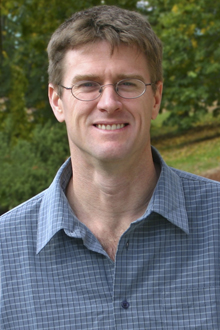Scientists find mechanism for cellular remodeling
Movie shows single molecules in action
Video has no sound.
Actin filaments are one of the primary elements responsible for organizing cell architecture and helping them to move from one place to the next. They can be found in the smallest yeast cell and in your muscles, where they contract when you run or throw a baseball. Understanding how cells know where and when to build new actin filaments, and how they are made, has been a central question in cell biology.
“Knowing precisely how a cell is built will enable scientists to reconfigure and repurpose them for various biomedical applications,” says Bruce Goode, professor of biology whose lab studies the cytoskeleton.
Until recently, scientists believed that there were different nucleators, or cell- igniters, responsible for making different types of actin structures or networks. But over the last few years, genetic research has suggested that nucleators might actually collaborate more often than they act alone.
 |
|
| Dennis Breitsprecher |
In a paper recently published in the magazine Science, members of the Goode Laboratory, in collaboration with members of the Lab of Jeff Gelles, illustrate that actin filament assembly relies on a mechanism they are calling the “Rocket Launcher,” which triggers new filament assembly in explosive stages.
And they have a movie to prove it.
The work was led by Dr. Dennis Breitsprecher, a postdoctoral researcher in the Goode lab, who placed fluorescent tags on each of three molecules: actin, which is the building block of filaments, mDia1, which is a member of the formin family of proteins that stimulates rapid growth of filaments, and adenomatous polyposis coli (APC), a mutated protein that causes over 80 percent of human colon cancers and binds, or connects, with mDia1. With these fluorescently tagged molecules, they were able to watch actin filaments polymerize in real time and see precisely how APC and mDia1 molecules collaborate to spark filament formation and growth.
 |
|
| Professor Bruce Goode |
“Cells have mechanisms in place that keep spontaneous formation of actin filaments, or polymerization, at bay,” says Goode. “This does not change until a nucleator, or a pair of nucleators in this case, has been deployed to a particular site in the cell and triggers new filament formation.’”
Goode uses an analogy with fire to explain further. The cell is full of kindling and oxygen, he says, but you can’t have a fire without a spark, and the nucleator really ignites the formation of each individual actin filament.
“They’re powerful proteins (mDia1 and APC), and it only takes one of each to come together in a pair and build a long filament that is comprised of thousands of actin molecules,” says Goode.
The movie was made with the help of multi-color Total Internal Reflection Fluorescence (TIRF) microscopy single molecule imaging , a technique pioneered in the Gelles lab. It allows researchers to image a small section of a specimen, less than 200 nanometers thick, and observe in real time the behavior of molecules in multi-component reactions that would otherwise be obscured.
The team used genetically encoded protein tags (called snap tags) and attached one single dye molecule per protein. In the movies, dots where the three proteins came together can bee seen in action; mDia1 tagged with a red dot, APC, with a blue dot and actin in green. They concluded that building new actin filaments occurs as a two-step process.
The team learned that APC plays the critical role in recruiting actin molecules to the initial complex to form a polymerization seed, while the mDia1formin functions to elongate and protect the filament end.
Building an actin filament under cellular conditions requires both proteins, said Goode. APC jumpstarts the formation of the filament, and the formin rides on the growing end and protects it from capping proteins that would otherwise terminate filament growth.
“This mechanism, where the proteins start off together before the formin launches away from the APC reminded us of a rocket launcher,” says Goode.
Categories: Science and Technology





